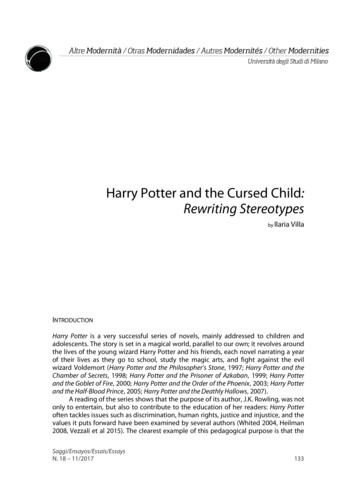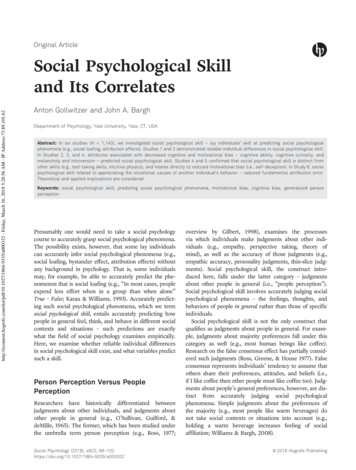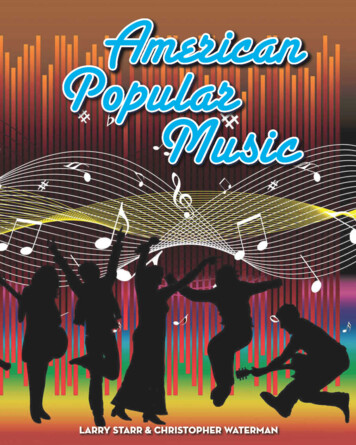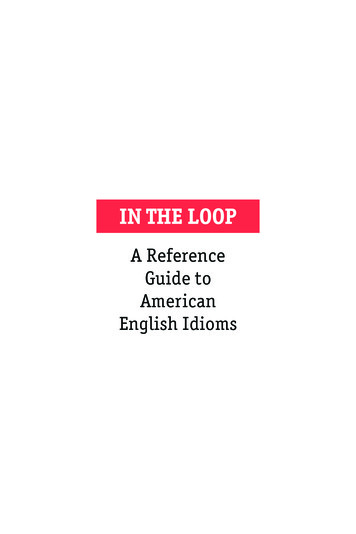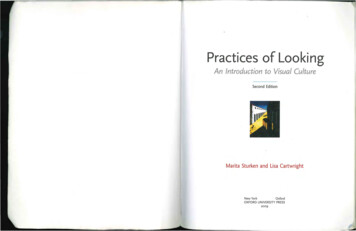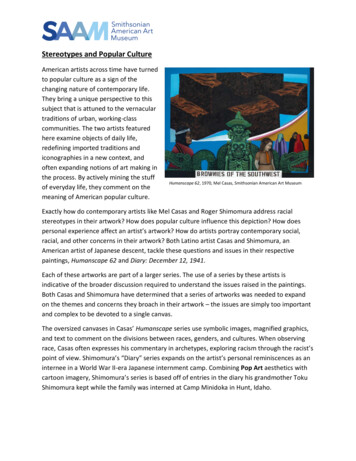
Transcription
Stereotypes and Popular CultureAmerican artists across time have turnedto popular culture as a sign of thechanging nature of contemporary life.They bring a unique perspective to thissubject that is attuned to the vernaculartraditions of urban, working-classcommunities. The two artists featuredhere examine objects of daily life,redefining imported traditions andiconographies in a new context, andoften expanding notions of art making inthe process. By actively mining the stuffof everyday life, they comment on themeaning of American popular culture.Humanscape 62, 1970, Mel Casas, Smithsonian American Art MuseumExactly how do contemporary artists like Mel Casas and Roger Shimomura address racialstereotypes in their artwork? How does popular culture influence this depiction? How doespersonal experience affect an artist’s artwork? How do artists portray contemporary social,racial, and other concerns in their artwork? Both Latino artist Casas and Shimomura, anAmerican artist of Japanese descent, tackle these questions and issues in their respectivepaintings, Humanscape 62 and Diary: December 12, 1941.Each of these artworks are part of a larger series. The use of a series by these artists isindicative of the broader discussion required to understand the issues raised in the paintings.Both Casas and Shimomura have determined that a series of artworks was needed to expandon the themes and concerns they broach in their artwork – the issues are simply too importantand complex to be devoted to a single canvas.The oversized canvases in Casas’ Humanscape series use symbolic images, magnified graphics,and text to comment on the divisions between races, genders, and cultures. When observingrace, Casas often expresses his commentary in archetypes, exploring racism through the racist’spoint of view. Shimomura’s “Diary” series expands on the artist’s personal reminiscences as aninternee in a World War II-era Japanese internment camp. Combining Pop Art aesthetics withcartoon imagery, Shimomura’s series is based off of entries in the diary his grandmother TokuShimomura kept while the family was interned at Camp Minidoka in Hunt, Idaho.
Humanscape 62Casas’ Humanscape 62 crystallizes many of the recurring concerns featured in Chicano art ofthe late 1960s and 1970s. Painted in 1970, this artwork is part of Casas’ “Humanscape” series,each which feature a large central image that evokes a television or movie screen, populatedwith everyday life imagery. Casas recounts how he was inspired to create his large six-foot byeight-foot paintings mimic large, outdoor drive-in movie theater screens: “When I paintedthose six- by eight-footers, again it wasn't that I decided, "Oh, I'm going to paint six- by eightfooters." What happened was that I was imbued with the power of the outdoor theater-themovie theater-and the big screen. And in a sense I'm consciously I was mimicking that.”The images explore the artist’s interest in psychology and popular media culture. Early“Humanscape” artworks explored how the media shapes our idea of beauty and desire – andthe dominance of what Casas’ called the “Barbie Doll Ideal,” referencing the white femalefigure. Yet as his series developed, the issue of race began to take precedence in Casas’ workand, not coincidentally, this development corresponded with the advent of the Chicano RightsMovement in the 1960s. The movement came to prevalence in the American consciousnessthanks to the tireless efforts of rights leader Cesar Chavez. Chicanos were active across a broadsection of issues including farm workers’ rights, education, and voting and political rights. Theyalso protested against the racial stereotypes portrayed in the media.One of the first protest campaigns to take on a specificstereotypical image was the campaign to eradicate theFrito Bandito, the sombrero-toting stereotypical mascotfor Frito-Lay corn chips featured on televisioncommercials. Speaking broken English and robbingunsuspecting bystanders of their Frito’s corn chips, theBandito character was drawn as a cartoon Mexican conman with a disheveled appearance and a gold tooth. TheBandito was also featured in several print ads whichdepicted the character on a wanted posters. The adwarns the consumer, “Caution: he loves crunchy Fritoscorn ships so much he’ll stop at nothing to get yours.What’s more, he’s cunning, clever – and sneaky!” The adalso warns citizens to protect themselves. The ad clearlylabels the Bandito as not only a dangerous immigrant,Frito Bandito print advertisement, 1968but it reinforces the commonly held stereotype aboutMexicans that they are lazy – the Bandito prefers to steal, rather than work.
Casas’s Humanscape 62 was created during the debate over Frito Bandito. Casas recalled, “I feltthe need to express something about what was going on.” In the painting, the artist hasincluded an image of the Bandito in green in the center of the painting. Frito-Lay responded topublic pressure and outrage by refining the Bandito’s appearance, grooming his hair and givinghim a friendlier expression. The change did not sit well with the public and ultimately Frito-Layreplaced Bandito with a new series of cartoon characters.The Bandito in Casas’ painting, as well as the other objects in the work, are all associated withbrown culture, or share a connection to “brownness.”The term gained popularity in the 1960s and 1970s andincreasingly signified Chicanos and their indigenousMeso-American ancestry. Casas has captured a group oftrivialized snippets drawn from popular culture making“brown” references, including a junior Girl Scout (knownas a Brownie), a jade mosaic sculpture of the Aztec deityQuetzalcoatl – the feathered serpent that extends thewidth of the lower register of the painting, a group ofMexican women, and a Native American in profile. Hugechocolate brownies occupy the majority of the topregister, and are a nod to something both commonplaceand historical. The popular cake-like brownies have theirorigin in Meso-America. Cacao beans, the source ofHumanscape 62 (detail)chocolate, was a prized agricultural product of theAztecs in the fourteenth century and could only be grown in the highlands of central Mexico.The section containing the brownies is slightly bowed at each end, an allusion to the firsttelevision screens which were similarly bowed. Casas has merged these references with thoseof indigenous culture to question the ways in which mainstream American popular culture hasdemeaned brown cultures, whether they be Mexican American or indigenous.Casas’ personal experiences as a bilingual American also influenced his decision to tackle theseissues in his artwork. The artist recalled:I realized that we had a bicultural problem. Meaning some of us were from a "Hispanicorigin." Accidentally that's the way it happens. Some were from "Anglo." Both of them inquotation marks, whatever that means. And even though we all are Americans I foundout I was less an American, and the reason I found out I was less an American is becauseI really spoke with an accent. Secondly, I was bilingual, and in America to be bilingual isto be suspect. We like to have all Americans speak only English.
Casas struggled with and raised the important issue of ethnic identity in art. As an Americanartist of Mexican heritage, but one who did not self-identify with the term Chicano, hewondered: were his paintings considered Chicano art because he was Chicano? Or was it thesubject matter that made the art Chicano art? In an interview, the artist recalled, “You havehere-in quotes-"Chicano artists," "Chicano group," so therefore they paint "Chicano art." Well,what is Chicano art? Is it Chicano art because it's an ethnicity thing? Or is it a subject thing?Those are the kind of questions I had that people didn't want to deal with.”Diary: December 12, 1941Having survived and largely repressed the trauma of his family's internment during World WarII and a childhood spent in the racially insensitive environment characteristic of the UnitedStates in the 1950s, Roger Shimomura had learned to minimize his differences with mainstreamwhite America. His discovery of a rich collection of family documents and memorabilia after thedeath of his grandparents inspired the artist to examine their lives as immigrants to the UnitedStates and, most importantly, the part of their lives he shared most intimately with them—theinternment years at Camp Minidoka in Hunt, Idaho.In keeping with mid-century American attitudes, Shimomura did not pursue formal training inthe language or culture of his forebears. When he began to examine his grandmother'sextensive series of diaries—there were more than fifty years of diaries beginning with herarrival from Japan in 1912 and continuing until her death in 1968—he required the services of atranslator. The diaries from the war years proved to be especially evocative, reviving earlymemories for Mrs. Shimomura's grandson and inspiring in him both the desire tocommemorate this reprehensible episode in our nation's history, and to share its lessons with anew generation of Americans.Between 1980 and 1983, Shimomura completed twenty-five paintings in the "Diary" series,each paired with a specific diary excerpt. Uniform in size and style, these paintings constitute apowerful collection of formally and emotionally compelling images. The flat, hard-edged formsand bright colors Shimomura uses to depict his shoji screens and kimonoed figures derive fromhis familiarity with ukiyo-e woodcuts and his admiration for the slick Pop Art images of artistssuch as Andy Warhol and Roy Lichtenstein. Shimomura refers to this tendency as his "love ofpainting flat."The painting entitled Diary: December 12, 1941, based on an entry dated five days after theattack on Pearl Harbor, is especially effective in suggesting the psychological dynamics of guilt,fear, and resignation involved in the Japanese-American dilemma created by that event. OnDecember 12, 1941, Shimomura’s grandmother wrote in her diary: “I spent all day at home.
Starting from today we were permitted to withdraw 100from the bank. This was for our sustenance of life, we whoare enemy to them. I deeply felt America’slargeheartedness in dealing with us.” Her words expressonly sadness and gratitude towards the Americanauthorities. Such an attitude is in keeping with the stoicbehavior of the Issei, or first-generation Japaneseimmigrants. Shimomura uses the Japanese word giri, whichmeans "hold it in and endure," to describe their way ofcoping. But in the painting, he emphasizes a growing feelingof isolation and confinement, symbolized by the dispositionof the converging screens that barely allows enough spacefor the figure.Diary: December 12, 1941 (detail)The normally nonthreatening figure of pop culture icon Superman is transformed into amenacing shadow, looming over the figure of Shimomura’s grandmother. The inclusion ofSuperman is a reference to Shimomura’s love of comic books. The artist grew up in the 1940’sand 1950’s during the heyday of action comics and superheroes, avidly reading cartoons likeDick Tracy, Superman, and several Walt Disney comics and cartoons. The graphic tradition ofcomics employs the thick outlines and flat silhouettes Shimomura would later come to use inhis artwork. Comic books are also stylistically similar to ukiyo-e prints; a connection Shimomuraacknowledged once, saying, “I realized that the only difference between Minnie Mouse and[the women in ukiyo-e prints] was race.”Despite Superman’s heroic persona in the comics, Shimomura interprets Superman in anotherway: “Superman is my response to the ‘large hearted American’,” a reference to hisgrandmother’s December 12th diary entry. Superman is not the all-American hero as heappears in the comics. In Shimomura’s artwork, he personifies a domineering American federalgovernment, responsible for imprisoning nearly 120,000 Americans of Japanese ancestry duringWorld War II.The painting’s crisp, colorful forms contradict its serious content and message. In the 1985catalogue for an exhibition of the “Diary” series, Shimomura commented on this contradictorycharacter, noting:The dichotomy between craft and subject [is probably] appropriate, like memory broughtback into focus. . . . It has always been of paramount importance to me that my work,beyond anything else, have visual interest. [These] paintings . . . were the most exciting
to work on because I have to deal with the relationship between political (literal) andvisual issues; in this case maybe a little like putting perfume over body odor.What lies beneath the surface of the canvas are serious issues of race, racism, assimilation, andthe complex entanglement of issues one faces as an American of non-European descent.Visual culture in contemporary art can be used to start discussions about how race and racerelations are part of our daily lives. In particular, the artwork of contemporary artists of colorasks viewers to consider the artist’s social position in relation to our history, which has beenshaped by our own experiences. The artwork of Casas and Shimomura urge us to considermultiple American realities and perspectives.GlossaryAndy Warhol: (1928-1987) American artist and filmmaker. He was a leading figure of the PopArt movement, and is best known for his work exploring celebrity and consumer culture.attack on Pearl Harbor: a surprise airstrike by the Japanese on the United States naval base atPearl Harbor in Hawaii on December 7, 1941, which led directly to the United States’ entry intoWorld War II.brown: a term used to denote a racial or ethnic classification. Generally, it is used to describepeople with “brown” skin tone who are of Hispanic or native ancestry.Camp Minidoka: one of ten internment camps Americans of Japanese descent were sent toafter the bombing of Pearl Harbor. Camp Minidoka, located in Hunt, Idaho, was the camp towhich artist Roger Shimomura and his family were assigned.Cesar Chavez: (1927-1993) union leader and labor organizer. Founder of the NFWA (later theUFW), Chavez advocated for farm workers’ rights and employed Gandhi’s tradition of peaceful,non-violent social change.Chicano: a chosen identity of an American of Mexican origin or descent. The term came toprominence during the Chicano Rights Movement. Some members of the community view theterm with negative connotations, as it was used previously in a derogatory manner.Chicano Rights Movement: a period of widespread social and political activism within theMexican American community during the 1960s and 1970s.Meso-American: (or Mesoamerican) of or relating to the people of Mesoamerica ortheir languages or cultures. Mesoamerica was the region and cultural area of the Americas
during the pre-Columbian era (pre-1492) which extended from central Mexico to Honduras andNicaragua.Pop Art: a style of art based on modern popular culture and the mass media, especially as acritical or ironic comment on traditional fine art values. The Pop Art movement began in the1950s, reaching its peak in the 1960s. Major artists of the movement include Andy Warhol andRoy Lichtenstein.pop culture: short for "popular culture," the term describes cultural activities or commercialproducts reflecting, suited to, or aimed at the tastes of the general mass populous.Roy Lichtenstein: (1923-1997) American artist and illustrator. A leading figure of the Pop Artmovement, he is best known for his boldly colored parodies of comic strips and advertisements.ukiyo-e: a Japanese genre of art depicting subjects from everyday life, which flourished fromthe seventeenth to nineteenth centuries.
thanks to the tireless efforts of rights leader Cesar Chavez. Chicanos were active across a broad section of issues including farm workers' rights, education, and voting and political rights. They also protested against the racial stereotypes portrayed in the media. One of the first protest campaigns to take on a specific


